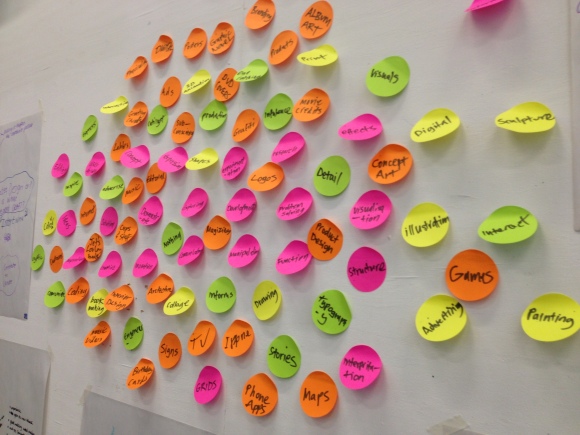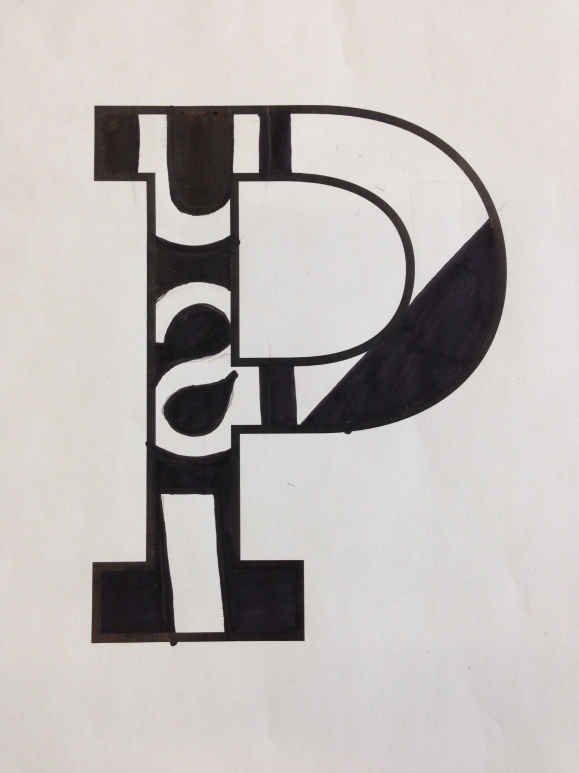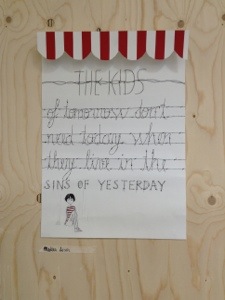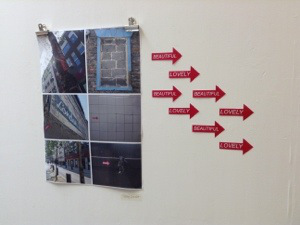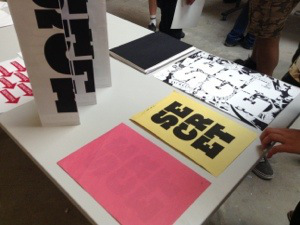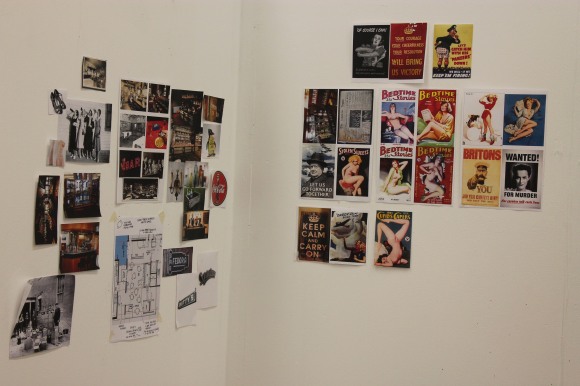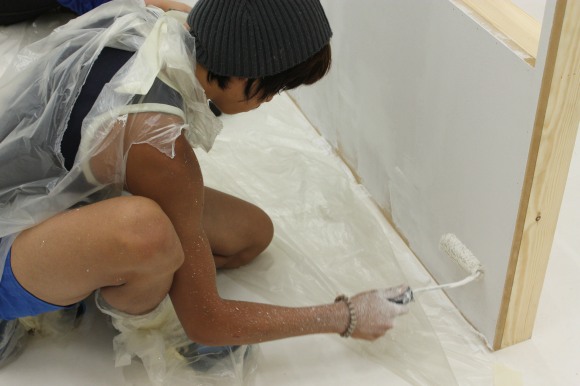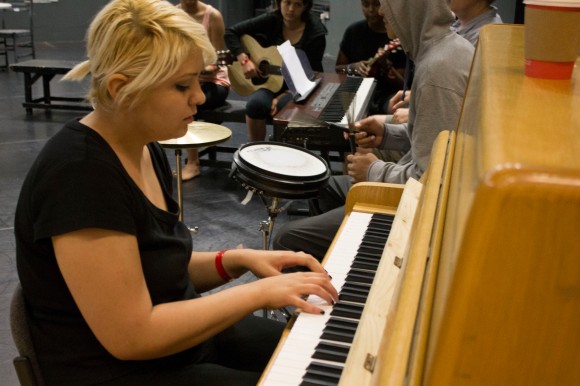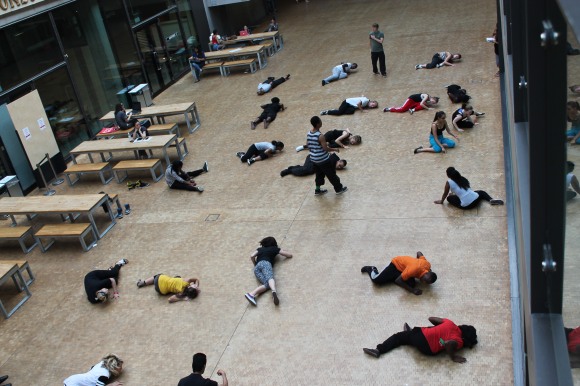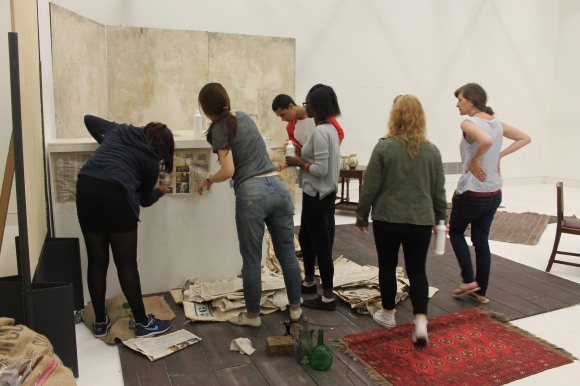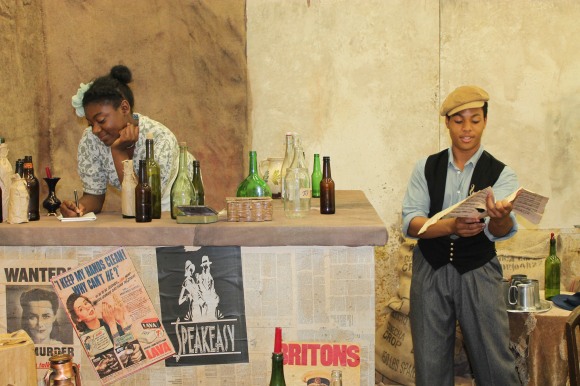
*JetFace*
"Hope is the only thing stronger then fear"
Category Archives: Documentation. Ideas, Create.
Pattern Talks
A series of informal talks in the gallery where artists, designers and scientists share their pattern passions.
Monday 3rd Nov
1.00pm Amanda Windle
DigiLab LCC, Data Patterns
Catherine Dixon
Typographer, CSM Typographic ornament
Tuesday 4th Nov 1.00pm
Graeme Gibbons
LambdaPhoto, Electron Microscopes
Wednesday 5th Nov 1.00pm
Philip Ball
Science writer, Genetic Patterning
Thursday 6th Nov 1.00pm
Charlotte Hodes
Artist, LCF, Cultural Patterning
Rob Kesseler
UAL, Micro Patterns
Micro Pattern Lab
The Lethaby Gallery becomes a working laboratory where you will be able to explore a world too small to be seen with the naked eye. Working from a collection of microscope kits supplied by the Royal Microscopical Society and their collection of slides, you can explore the materials we use every day in our work and the world around us to reveal complex textures and patterns.

From Tuesday 4th November for three days there is also a unique opportunity to use a state of the art Phenom scanning electron microscope on loan from Lambda Photometrics with the capacity of magnifications of up to x 10,000. Nottingham University have also given access to a selection of their online interactive anatomical slides. A small Dino Lite plug in microscope will be available to track, photograph and take movies of anything from your skin to fabrics and plant material. The images that all these microscopes reveal,
provide an opportunity to create a new landscape of pattern through graphic and digital media. Drawing with one eye looking down the lens and one on the paper, new topographies of pattern can emerge. Shifting from the graphic to the digital and from the micro to macro an HP large format printer will offer the possibility of expanding the scale even further.
More on MiPattern Blog
Mi Pattern

Modes Of Design



I started the context unit based on my curiosity, which was triggered form the ‘Who Am I’ exhibition at the science museum. I felt that it was important to me to take the opportunity to research and learn about something different. The process started with a genuine interest in science and the methods used. I believe that my piece was also highly influenced by the detective show CSI. This helped to narrow down to forensic photography. I was interested in the methodology and the history behind it.
My curiosity continued to structure my interest area, which evidently grew through out my research. When I started, my intentions for the design was to create a supporting creative work that would enhance what I would talk about and what I had discovered. I missed judge time and it is clear to me now that my idea to create my own crime scene was far to ambitious, telling a story through a series of photography’s. Not only did I want to create my own crime scene I was too naive in thinking I would have enough time to learn and take the opportunity to work with a more traditional type of photography. Learning to use analogue photography to get a better feel and idea of photography and the way it was appreciated before.
The nature of the project was covering an extensive topic, which needed to be thoroughly researched in order to grasp an idea of how I could marry my written piece with the design. My ideas were beginning to generate but in a very general way, I think that talking to my context tutor helped to narrow down and conclude it to a relevant design. The struggle, was understanding the field and reflecting that across, my first intentions was that my only solution to a creative piece was to produce a book that displayed all the content, which would balance out the aesthetics and the written content. As my research in to the field expanded I started to get a clearer idea on what interested me. I was interested in the way photography was used as a form of identification, which was documented and recorded as evidence in law enforcements. Understanding the power photography held.
From the influence of my research and CSI, I started to consider my concept for my visuals with more consideration. I established that my visuals needed a concept that was addressed in a more traditional form, which would instantly be recognised for its purpose. I needed to make sure that visuals had to integrate text an images in a relevant way. In order for my out come to work I needed to make sure that I kept my visual as simple as possible. My visual is divided into five archive files. I wanted to portray, authority, power and official importance as if a criminal case. The brown symbolizes the traditional colour used for achieves.
I used letterpress to produce the labelling on the covers. I felt that this form of technique added to the attention to detail which is manifested in the late 19th century and early 20th century. I believe it added affection and a reminder of history to the visuals. It was essential to keep the design of the text very simple, as in normal forensic reports there isn’t much of a structure to the text layout, just a simple word report. For me this aspect was very important to be portrayed simple because the content is more important then anything else in a normal case.
In terms of images, they are all printed in large scale to covey their importance of truth and reality? Also to focus on the attention to detail. At first I was going to bind the pages, however the option to leaving the pages free seemed better, as normally investigators would take out images and other relevant content on the table in order to calculate and solve an investigation. I tried to maintain a simple theme through out the visual identity of my dissertation.
The outcome, allows the reader to choose sections of the content in any order. It allows the reader to interact with the material and grasp an understanding of theory, history and the images itself. I strongly believe that the visual outcome expresses the characteristic nature of the text in a valuable and formal way. In all honesty I did struggle with understanding the theories and principles of my subject but I have enjoyed taking the risk of learning something new that was out of my comfort zone. I believe that there is a lot of potential for further exploration. Over all I am pleased with my out come and with achieving an academic piece of writing.
The Bigger Picture-Talks
Elaine Glaser
Elaine Glaser talked about authenticity; she observed the behaviour of people in power and how they portrayed a ‘Fake’ image of themselves for consumers. “Appearance and reality” creating an image that is very reserved from their services. Showing their hidden intentions, which seem to manipulate the public. She gave examples of David Cameron: sleeves rolled up, no tie giving an informal presentation as a ‘man of the people’. Michelle Obama: growing her own garden, showing independence as a female. Outlining their efforts of creating an impression that they are just ordinary people doing ‘normal’ things.She also showed example of big brand like McDonalds: Creating a heart-warming advert of where their potato’s come from, and Starbucks growing their own coffee bean in their retail shops. Manipulating people with their creation of this ‘authentic’ trend which is distracting people from the facts and reality (creating an illusion)To a certain extent I agree with Elaine’s views that public figures are portrayed in such a manor that they are made to see as “normal” when in actual fact their lives and responsibilities are completely different from the average man /woman. It also needs to be said that Elaine has taken fragments of their public life in order to obtain this conclusion, which may have been taken out of context.
Evan Davis
Evan Davis talked about two main strategies: physical production and intellectual properties. Physical production: the inventions of the factory, and the revelation of production that made a difference and great contribution to Britain’s economy. It was clear that manufacturing has become less and less important for Britain as entry level countries have adopted the manufacturing world as a way of getting rich quick. He mentioned Baumol’s law: the evolution of the factory that has became more advanced as countries got better and better in manufacturing, however this has meant that fewer and fewer people are employed. The second big thing you can sell is intellectual properties and most of the advance, have moved in that direction. The creative stuff comes from where capitalism is developed. It is evident in order for manufacturing and intellectual property to work there has to be a system where the two are balance out in the distribution. London is the Hub of intellectual property, selling service to counties the designing and producing the idea where then they do the next stage and that is manufacturing. If this system didn’t exist then countries will become self-contained and not rely on others around the word.
James Woudhuysen
James speech was based on leadership and innovation. His talk was about leader staying strong and having the drive to be ambitious, pushing for a better future. Leadership is about fixed intention: it should not be about emotional attraction he wanted people to open their eyes, assess risks sense the possibilities and research the future. He had this idea that with out leaders there would be no goals (objectives) building a whole new world because a nudge in the right direction would not make a change. He wanted us designers to be a lot more aware of the word and what’s happening around us, having the ambition to do better and have some sort of solidarity.
Anna Minton
Anna Minton spoke mostly about the privatised cities that are managed, business improvements districts and bring them together to manage. She also talked about policy a change enforces, this meant that places are treated as products and in some cases public goods are replaced by economic gain. There were issues with the policy like planning and compulsory not assessable to a pubic audience. As new legislation are brought in, Minton believes that there would be more power like police and that there would be a loss of security for ordinary people like park keepers bus conductors etc. With a growing obsession with security creates a less trusting environment. Minton concluded her talk about the future, looking for a balanced local economy give people some sort of hope, bring identity and diversity to communities that would help strengthen democracy trust and happiness.
Matthew Taylor
Matthew Taylor started his speech with asking a question: Why is that we find it so difficult together to achieve thing that we want to? He talked about the fact that we don’t know how to solve problems in society because there’s a gap and we’re not thinking and not growing and the solution requires us to use three major sources, well springs of power that reflect who we are. As Taylor said there are three fundamental characteristic of us and they are survival, collaboration and leadership and follower-ship. They are then reflected in three great sources of power: hierarchy, solidarity and individualism. Hierarchy have failed us people are losing faith, they are becoming weaker and weaker losing their sense of authority, technology used to be something that gave them power they were the only ones that could afford technology. Solidarity is weaker and diversity has changed which is harder to feel solidarity with people who are different to you. Individualism has grown to fill the gap that is left from the decline of hierarchy and the decline of solidarity. Individualism has too become narrow and materialistic motion of individualism. Challenging the narrow idea of what it is to be successful.
Angela Saini
The technological fix, which Angela talked about, was trying to find a solution in solving the world’s problems using technology creating this ideal world of hope. She talked about a very human idea that could shape the public understanding of the world. People believed that the idea of technology would help solve social problem such as war, crime etc and this idea was the atomic boom. As Saini went deeper in to her speech the more ideal her ideas and hopes became on solving problems and real social issues of the world. It was something she wants to see happen. A future that could be ’fixed’ with out having to change our lifestyles, ‘technology will bring salvation’. She talked about people still believing in the idea of technology being a big simple signal ‘fix’ solutions to our biggest problem like food crises, climate change and people are convinced that scientist can achieve this ‘idea’ making very thing ok.
VOTE MILOT10
This is a start in the making. My little brother has a great passion for football and a few weeks ago entered a competition to win a day training with Robin Van Persie and he has enter the top 20 finalist. So happy for him. Now all he needs is some votes so please vote for him.
Vote for my little brother Milot here Milot
Jet x
Heroes and Heroines Photography Competition and Exhibition.
My entry for the Heroes and Heroines Photography Competition and Exhibition.
The brief was to Produce a photographic self portrait in the style of a hero or heroine, I don’t really have a hero but wanted to enter just because I thought it would be fun and interesting to see what people would come up with. After a lot of thinking I decided to base it on some who is fairly new. Rita Ora. I picked her because she’s from Kosovo where I’m from and a great influence. I just like the fact even though Rita has been brought up in London she still is quite patriotic about her place of birth. The other thing I like about Rita is that she seems very dedicated and energetic about what she does which i like that a lot in her. I think they’re the two most important ingredients to have if you want to be successful and get somewhere in life. (harsh but true :/)
So what I decided to project a video of her’s from youtube on me. I thought it worked well but i think if I had more time I would have like to have experimented a lot more and maybe capture it differently.
My entry
The video I projected
Till next time
Jet


